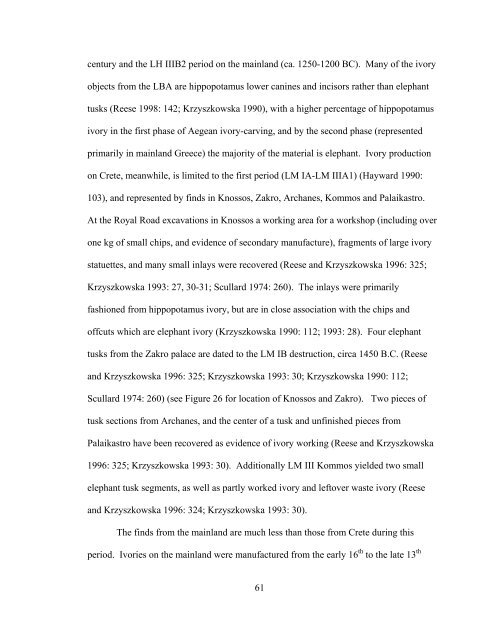Tracing the Source of the Elephant And Hippopotamus Ivory from ...
Tracing the Source of the Elephant And Hippopotamus Ivory from ...
Tracing the Source of the Elephant And Hippopotamus Ivory from ...
Create successful ePaper yourself
Turn your PDF publications into a flip-book with our unique Google optimized e-Paper software.
century and <strong>the</strong> LH IIIB2 period on <strong>the</strong> mainland (ca. 1250-1200 BC). Many <strong>of</strong> <strong>the</strong> ivory<br />
objects <strong>from</strong> <strong>the</strong> LBA are hippopotamus lower canines and incisors ra<strong>the</strong>r than elephant<br />
tusks (Reese 1998: 142; Krzyszkowska 1990), with a higher percentage <strong>of</strong> hippopotamus<br />
ivory in <strong>the</strong> first phase <strong>of</strong> Aegean ivory-carving, and by <strong>the</strong> second phase (represented<br />
primarily in mainland Greece) <strong>the</strong> majority <strong>of</strong> <strong>the</strong> material is elephant. <strong>Ivory</strong> production<br />
on Crete, meanwhile, is limited to <strong>the</strong> first period (LM IA-LM IIIA1) (Hayward 1990:<br />
103), and represented by finds in Knossos, Zakro, Archanes, Kommos and Palaikastro.<br />
At <strong>the</strong> Royal Road excavations in Knossos a working area for a workshop (including over<br />
one kg <strong>of</strong> small chips, and evidence <strong>of</strong> secondary manufacture), fragments <strong>of</strong> large ivory<br />
statuettes, and many small inlays were recovered (Reese and Krzyszkowska 1996: 325;<br />
Krzyszkowska 1993: 27, 30-31; Scullard 1974: 260). The inlays were primarily<br />
fashioned <strong>from</strong> hippopotamus ivory, but are in close association with <strong>the</strong> chips and<br />
<strong>of</strong>fcuts which are elephant ivory (Krzyszkowska 1990: 112; 1993: 28). Four elephant<br />
tusks <strong>from</strong> <strong>the</strong> Zakro palace are dated to <strong>the</strong> LM IB destruction, circa 1450 B.C. (Reese<br />
and Krzyszkowska 1996: 325; Krzyszkowska 1993: 30; Krzyszkowska 1990: 112;<br />
Scullard 1974: 260) (see Figure 26 for location <strong>of</strong> Knossos and Zakro). Two pieces <strong>of</strong><br />
tusk sections <strong>from</strong> Archanes, and <strong>the</strong> center <strong>of</strong> a tusk and unfinished pieces <strong>from</strong><br />
Palaikastro have been recovered as evidence <strong>of</strong> ivory working (Reese and Krzyszkowska<br />
1996: 325; Krzyszkowska 1993: 30). Additionally LM III Kommos yielded two small<br />
elephant tusk segments, as well as partly worked ivory and leftover waste ivory (Reese<br />
and Krzyszkowska 1996: 324; Krzyszkowska 1993: 30).<br />
The finds <strong>from</strong> <strong>the</strong> mainland are much less than those <strong>from</strong> Crete during this<br />
period. Ivories on <strong>the</strong> mainland were manufactured <strong>from</strong> <strong>the</strong> early 16 th to <strong>the</strong> late 13 th<br />
61

















